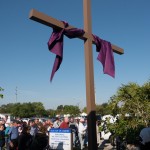 On Good Friday, thunder showers and the threat of more thunder showers forced the Good Friday Ecumenical Walk indoors. The organizers were prepared for this contingency. We gathered in Our Lady of Lourdes Church in Melbourne and did a virtual walk with digital images of the “stations.”
On Good Friday, thunder showers and the threat of more thunder showers forced the Good Friday Ecumenical Walk indoors. The organizers were prepared for this contingency. We gathered in Our Lady of Lourdes Church in Melbourne and did a virtual walk with digital images of the “stations.”
The Walk took on a whole new dimension for me. Usually, sometime into the walk the muscles start to garner more of my attention. On the actual walk, it is sometimes difficult to hear all the prayers and songs.
In the church setting, I was able to be fully attentive to the message at each station. The message was loud and clear at each station—where is Christ suffering today? I found myself overwhelmed by the plight of unloved, abused and trafficked children, veterans, PTSD, violence and the death and suffering all the victims of war, the daily plight of the hungry and the food challenged, the plight of lonely homeless people, the desperation of refugees and immigrants, and finally, the failure of government to help us address these blatant evils in our midst.
In many churches the faithful were attending Stations of the Cross which focused on how my sins drive nails into the hands and feet of Jesus. This excessive focus on sin and personal guilt for the suffering and death of Jesus often misses the point—Christ is suffering in many places and in many ways today because people miss the call to love one another and to alleviate human misery. We have moved beyond slavery but human trafficking and racism sometimes run rampant. We have moved beyond blatant discrimination against women but sometimes they are still treated as second-class citizens. Progress is slow; however, the churches’ failure to live up to the Gospel message is scandalous. Many focus on me-and-Jesus when the focus should be on Christ-and-us.
I was in a blue funk the rest of the day. The challenges for us, the Body of Christ, loom large. Out of the depths my heart cried unto the Lord. As the day went on, it began to sink in. I was at the void, in the abyss of powerlessness. Was this the “hell” Christ descended into after his crucifixion? Abandoned by disciples who still did not understand, Jesus was crucified by the Romans because he posed a threat to their system of peace through the violence of war, conquest and domination. I understood more deeply how Jesus must have suffered his way to the abyss where he let go of the last vestiges of the false human self and abandoned himself to the will of the Father.
Jesus is a model for our letting go of our false self, the self we think we are. As we confront mass injustice, the ego self often gets in the way. When we reach the point of being completely overwhelmed, we have to cry, “My God, my God, why have you forsaken us?” We have to cry out before we submit, “Father, into your hands we commend our spirits.”
Then, in the depths of the abyss of nothingness, we realize our own powerlessness and understand that all things are possible with the Risen Christ. We have to live in the between, as Richard Rohr says. We live in the vertical in-between of God and human. We live in the horizontal in-between of the Good Thief and the Bad Thief within us. We live with paradox. As with Paul, the good within us is often overcome by that which we would not do. We are powerless to become more than what we are without the Spirit of the Risen Christ dwelling deep within.
Mother Teresa and Thomas Merton both remind us that we are not about results. Mother Teresa said, “God doesn’t require us to succeed; he only requires that you try.” Thomas Merton wrote:
Do not depend on the hope of results. You may have to face the fact that your work will be apparently worthless and even achieve no result at all, if not perhaps results opposite to what you expect. As you get used to this idea, you start more and more to concentrate not on the results, but on the value, the rightness, the truth of the work itself. You gradually struggle less and less for an idea and more and more for specific people. In the end, it is the reality of personal relationship that saves everything.
Our call is to be faithful to the Risen Christ and to proclaim Gospel values. Christ life is life lived in relationship. The Risen Christ is responsible for the results, slow as they may sometimes seem.
We live. We lament. We mourn. We die to self. Then, the Risen Christ lives in us. We live. We rejoice. We dare to hope. We love. We live, now not us, but Christ lives within us. One foot is on slippery rock of despair while the other is on the solid rock of Gospel hope. Is the Risen Christ our salvation and our hope? Jesus Christ is risen today. Alleluia!!!
